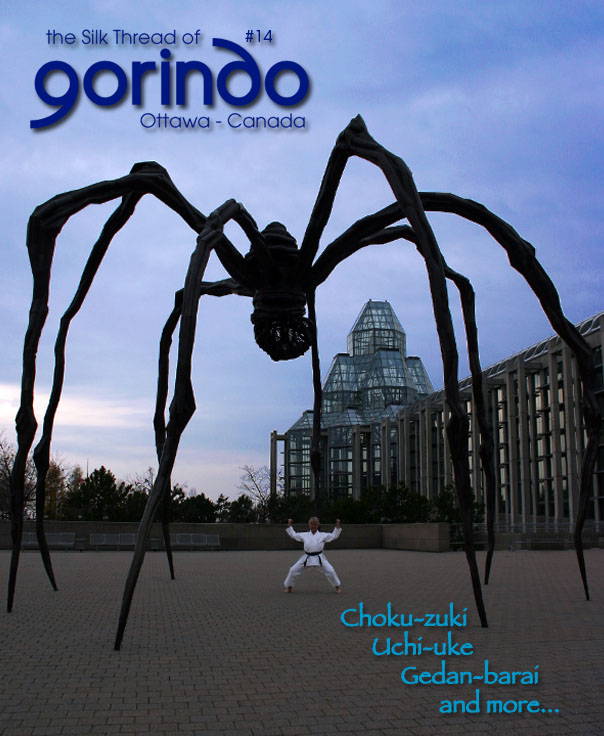
The Silk Thread of Gorindo - Ottawa - Canada
Issue 14
- Middle Block In-outside - Uchi-uke
- Downward Block - Gedan-barai
Photo cover Roxanne Standefer sensei with Louise Bourgeois's Maman, a sculpture of a giant spider outside the National Gallery of Canada's main entrance, Ottawa, Ontario, December 2011. Photo by Claudio Iedwab.
Downward Block - Gedan-barai

One of the most sensitive and weak targets is the groin area, and perhaps the most easy to attack as well. An essential defense technique is the low parry or low block, gedan-barai.
 From the heiko-dachi,parallel stance feet shoulder width apart pointing forward, raise the fist that you will use for defense, directly across and over the opposite shoulder. Meanwhile extend the other fist out in front of your solar plexus to protect your body between two consecutive blocks.
From the heiko-dachi,parallel stance feet shoulder width apart pointing forward, raise the fist that you will use for defense, directly across and over the opposite shoulder. Meanwhile extend the other fist out in front of your solar plexus to protect your body between two consecutive blocks.
The back of the hand of the defensive fist is to the outside, allowing you to twist the forearm during the defensive trajectory. The twist is important to avoid the absorption of the impact on only one point during the contact with the adversary’s attack. It is preferable to distribute the force around the arm and avoid injury. Use the tensed muscles of your forearm to make contact, not the wrist or bones because they are very sensitive to damage and breaking if the impact is very strong.
From the chambering position, draw your arm in an arc down and across your body until your elbow is extended. Don’t straighten it totally, thus avoiding hyper-extension. The arm travels low (below the belt) until it is in line with the opposite side of the body, with theback of the hand outside and up with the wrist straight. The block must move across the body in a manner that ensures complete coverage of your groin area. When the technique is complete the elbow should be about one fist distance out from your ribs.
Don’t try to stop the attack cold, try to ‘go with’ the movement and deflect its trajectory.
Exhale your air when you do the technique and use ‘explosive’ tension of your body at the moment of contact. Constantly keep your view forward on a horizontal line in front of you, not watching where your forearm goes.
The other fist moves back sharply to a position beside the floating ribs (with the back of the hand down), with the idea in mind of doing an elbow strike behind you at the same time that you do the low parry.
Keep the hips and shoulders in perpendicular relationship to the block at the end of the motion. The back and the head remain vertical.
Gedan-barai can be used against kicks or punches to the abdomen or groin area in defensive motion, also for striking to the adversary with your forearm or a hammer fist in the lower arc of the trajectory.
Gedan-barai can be trained in all the stances, but for beginners it is recommended to train in parallel stance, heiko-dachi; forward stance, zenkutsu-dachi; and horse stance, kiba-dachi.
Common Corrections
• The movement begins too low at the opposite shoulder, or without the back of the hand pointing upwards and outwards (you can’t generate enough power or twist).
• Passing the profile line at the end of the lower parry (expending more energy than necessary and leaving your center open).
• Not blocking below the belt level and therefore not protecting the groin.
• Hyperextension of the elbow with the possibility of injury.
• Using the bone area for contact. Blocking too hard in training. Begin gradually slowly increase speed and effort.
by Claudio Iedwab & Roxanne Standefer
Originallly published in the Gorindo Student Manual by Claudio Iedwab & Roxanne Standefer
©2011 Illustrations by Claudio Iedwab
- Middle Block In-outside - Uchi-uke
- Downward Block - Gedan-barai
« Click the Subscribe link on the left




